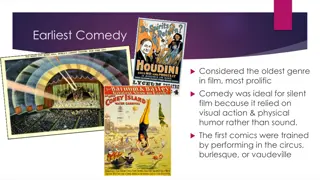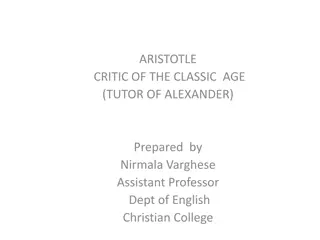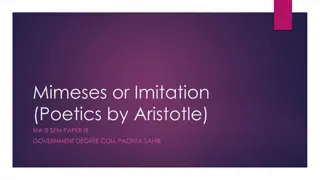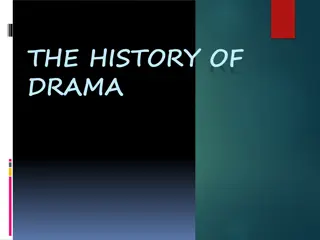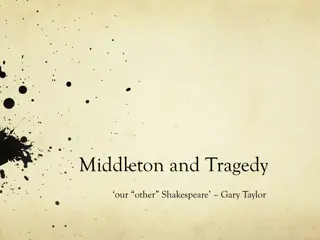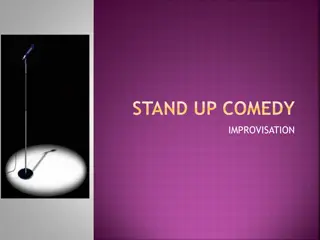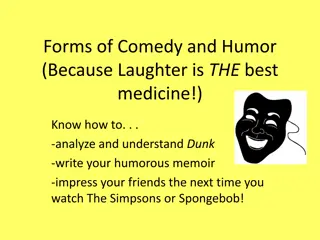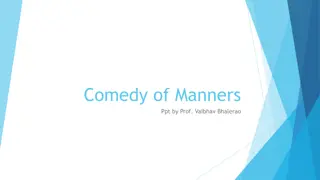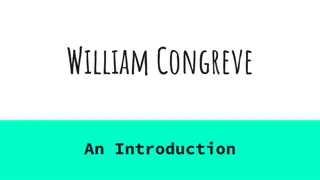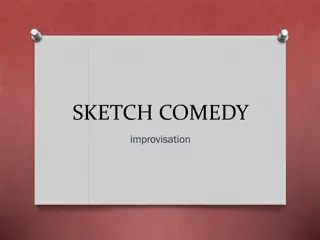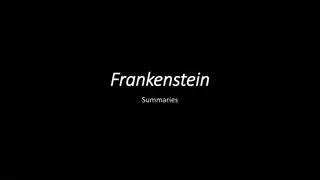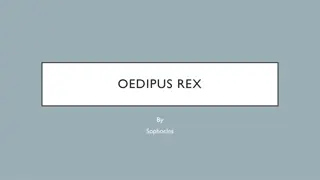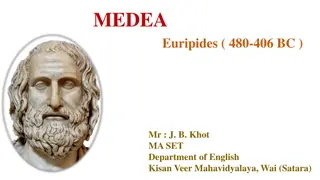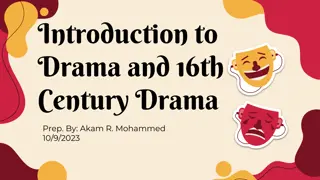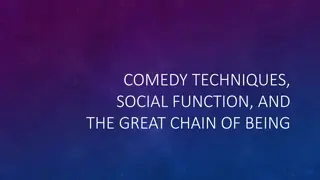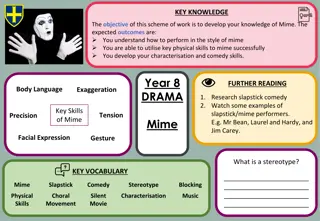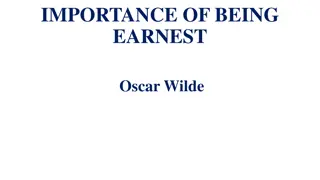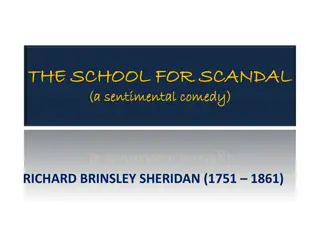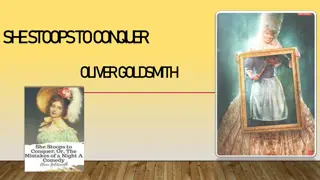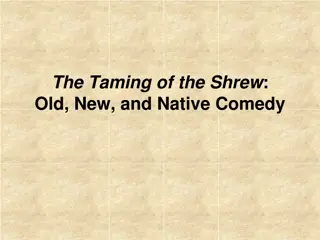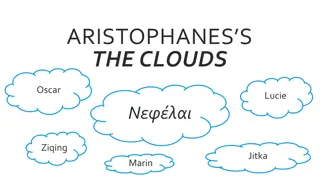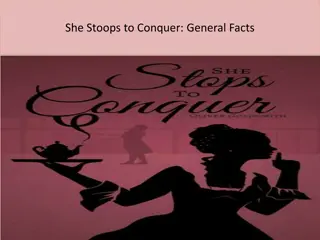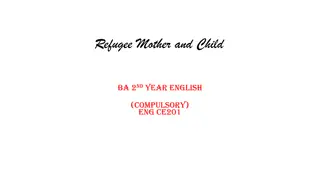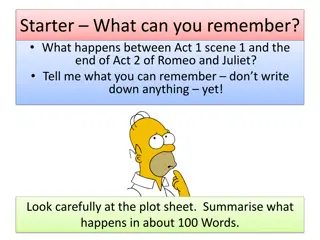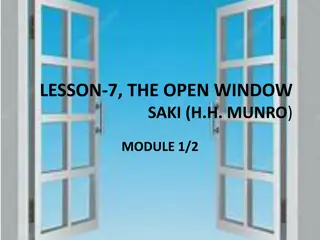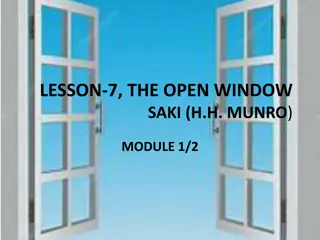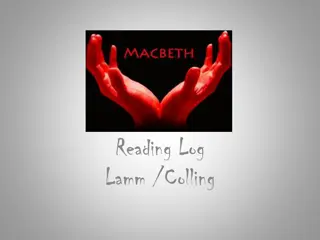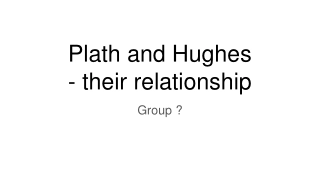Aristotle's The Poetics: Tragedy and Comedy Analysis
Aristotle, the Greek philosopher, introduced key concepts in his work The Poetics, focusing on tragedy and comedy. He countered Plato's views on literature and emphasized the importance of imitation, catharsis, and the unity of time, place, and action in dramatic composition.
Download Presentation

Please find below an Image/Link to download the presentation.
The content on the website is provided AS IS for your information and personal use only. It may not be sold, licensed, or shared on other websites without obtaining consent from the author. Download presentation by click this link. If you encounter any issues during the download, it is possible that the publisher has removed the file from their server.
E N D
Presentation Transcript
Aristotle (384 322 BCE) Greek philosopher born in Macedonia Son of Nicomachus, physician to the king Entered Plato s Academy at age 18 c. 342 BCE began tutor to Alexander the Great Founded the Lyceum Principal writings: The Poetics, The Metaphysics, On the Heavens, Nicomachean Ethics, The Politics
Plato vs Aristotle Plato Aristotle The world is ONE Thought is holistic Inquiry method is dialectical Value of a work of art or literature is extrinsic; it must be useful beyond itself The world is MANY Thought is specific Inquiry method is problematic Value of a work of art or literature is intrinsic; it has its own value
Aristotle, The Poetics Written to counter Plato s argument that literature is an appeal to the irrational Is primarily concerned with poetry and tragedy, but also discusses comedy briefly Defines tragedy and analyzes its qualitative parts
The Aristotlean Method of Analysis Aristotle considers tragedy or epic a productive science and uses the same method of four-cause analysis that he does in other sciences. An artifact or product is defined by its: Shape: the formal cause Composition: the material cause Manner: the efficient cause End or Purpose: the final cause
Application of the method to drama Shape or Formal cause: imitation of serious action Composition or Material cause: language, rhythm, harmony Manner or Efficient cause: drama or narrative Purpose or Final Cause: Catharsis or purging of pity and fear in the viewer
Some important ideas in The Poetics Aristotle introduced the concept that has shaped dramatic composition the unities of time, place, and action. For Aristotle the poet/playwright is not divinely inspired as Plato suggests, but motivated by a universal human need to imitate. Imitation (mimesis) has a civilizing value for those who empathize with it. The purging of feelings of pity and terror (associated with tragedy) leave a viewer in a better emotional state. Literature, then, satisfies and regulates human passions instead of inflaming them.
Literary Criticism Began with Plato and Aristotle; has had a continuous development since antiquity Uses specialized terminology: Mode: broad categories of material (romance, tragedy, comedy, satire, irony) Genre: types of literature organized by technique or subject matter (novel, poem, short story, essay, play) Theme: the central or dominating idea
Modes of Tragedy & Comedy Over time literary critics have developed terminology around modes, genre, and themes that shape discussion. This began with Plato & Aristotle. Some terms are drawn from the basic dichotomies of classical myth (Dionysiac, Apollonian). Others refer to playwrights whose work defined a certain modality (Aristophanes, Menander)
Fictional & Thematic Modes Mythic Romantic High Mimetic Low Mimetic Ironic Dionysiac Elegaic Classic Tragedy Pathos Scapegoat TRAGIC Apollonian Idyllic Aristophanic Menandic Low- Mimetic Sadism COMIC Scripture Chronicle Nationalism Individualism Discontinuity THEMATIC
The Function of Modes & Themes Modes and themes offer a viewer of tragedy or comedy a way to understand the characters by relating to them. The viewer may align himself or herself in real terms to gods, leaders, equals, etc. or in ways that offer an understanding of the larger societal meaning of the play. The viewer needs to know that a tragic mythic character will either act irrationally (like Dionysius) [a tragedy] or rationally (like Apollo) [a comedy]. In either case divine law informs human understanding (scripture).
Does this work in modern literature? Modern epics or tragedies generally involve more characters and use more themes than the classical dramas that Aristotle enjoyed. But modern epics do employ many of the devices Aristotle describes. Consider Tolkein s The Fellowship of the Ring. It is a mythic romance. Sauron and Gandalf represent the tension between the Dionysiac (irrational) and the Apollonian (rational) elements in the divine character. Both are superior in kind to the reader. The various heroes (Aragorn, Frodo) each reach out to the reader/viewer on a particular level. Aragorn is both mythic and romantic, but in an idyllic way. He integrates himself into a new society and fulfills his destiny. And so his people celebrate him. Frodo is romantic, but in an elegaic way because cannot re-integrate. And so the Hobbits mourn him. Both are superior in degree to other humans either because of background or because they have special advantages (the ring). The Hobbits Merry and Pippin are the placeholders for all of us in a national chronicle.
The Hero Whether the story is a tragedy or a comedy, the central character is the element around which the action flows. The reader or audience is expected to engage with this hero and assumes a perspective in relationship to the hero as the action begins.
Northrup Frye: Perspective of the Hero If the Hero is He is Mode is Genre is Superior in KIND to other men and the natural environment Divine Myth Myth Superior in DEGREE to other men and to the environment Marvelously Human A leader Romance Legend or Folktale Epic or Tragedy Superior in degree to other men, but not to the environment Superior neither to other men or to the environment; one of us Inferior in power or intelligence to ourselves High Mimetic Normal Human Low Mimetic Comedy Absurd Human Ironic Irony
What is comedy? The basic requirement of comedy is a happy ending. The formula of comedy has more to do with conventions and expectations than with jokes or other humor. THE COMEDY IS A STORY OF THE RISE IN FORTUNE OF A SYMPATHETIC CENTRAL CHARACTER. Ethos is central. The social context of the hero and the way he or she acts on values shared with the audience shapes the viewer s reaction.
Elements of Comedy A comedy is about ordinary people and situations. The audience is on an equal level in perspective with the comic hero and the cast of supporting characters. Characters do not have to imitate actions, but rather replicate everyday situations that the viewer can anticipate. This makes the modality low mimetic.
The Comic Hero The main character must be recognizably human in every way, having just enough charm or worth to gain the support of the audience. Aristotle says that the comic figures are average to below average in moral character. They are often clever servants or charming knaves. Classic examples in literature are Huck Finn or Shakespeare s Falstaff. Sometimes the comic hero or heroine is of low birth, but has obvious real worth. Watching such a character rise in fortune is a stock plot of comedy. If the main character is worthless or totally inept, the play is not a comedy. It is a farce, and the modality is ironic. Ridiculous characters who are self- important rather than noble are featured in the farce or low comedy. In a farce the main character is not supported by the audience, but suffers its contempt.
What is tragedy? Tragedy is the mirror image or negative of comedy. Tragedy is a story of the downfall of a sympathetic central character. Pathos is central; the audience is moved to pity by the downfall of the hero.
The Origins of Tragedy Tragoedia is a Greek word meaning goat song. Its origins are perhaps linked to the singing of a choral lyric (dithyramb) on a circular dancing floor (orchestra) by a group of men impersonating satyrs and dressed in goat skins. Eventually dithyramb widened from a simple chant to include mythic stories, and an actor (hypokrites an answerer [the origin of our word hypocrite]) was introduced to answer questions posed by the chorus. This actor gradually became the hero and one or two more actors were added as foils to his story.
The Nature of Tragedy Greek tragedy depicts the downfall of a noble hero or heroine through a combination of excessive pride, fate, and the will of the gods. Essential to tragedy is the audience reaction to the fall of the hero. The audience must engage with the dilemma and choices of the hero, and see himself or herself as potentially suffering in the same way. This is why most tragedy in western literature is either high mimetic (noble hero) or low mimetic (ordinary hero). Imitation is the key to audience sympathy.
Aristotle, Poetics, Chapter VI Tragedy, then, is an imitation of an action that is serious, complete, and of a certain magnitude; in language embellished with each kind of artistic ornament, the several kinds being found in separate parts of the play; in the form of action, not of narrative; through pity and fear effecting the proper purgation of these emotions.
Aristotles Six Elements of Tragedy Mythos (Plot: the most important. It will always include pathos.) Ethos (Character and setting) Diction (Verbal Expression) Dianoia (Thought, i.e. theme) Spectacle (Visual adornment) Melody (Song-composition)
The Tragic Hero A tragedy deals with a hero s separation from society. This separation is most often the ultimate one death. Separation applies to Frye s modes in this way: Mythic: death of gods Romance: Mourning for the death of heroes High mimetic: death or suffering of a noble human Low mimetic: the death or sacrifice of a normal human like ourselves Ironic: the death or suffering of a weak and pitiful human being.
Some Examples of Modes Mythic: Hercules Furens (about the mad Hercules) Romance: King Arthur, Beowulf, Odysseus High mimetic: Oedipus Rex, Hamlet, Othello, The Crucible Low mimetic: Ethan Frome, Tess of the D Urbervilles Ironic: Kafka, The Hunger Artist
Fundamental Elements Involved in the dynamics of this downfall are the essential elements of tragedy: Pathos (suffering) Hubris (excessive pride) Harmartia (tragic flaw) Anagnorisis (tragic insight) Peripeteia (reversal of fortune) Catharsis (emotional purging and return to a healthy emotional balance)
Pathos Suffering The fundamental dynamic in Aristotle s definition of tragedy. There are two aspects to pathos: Pity or compassion for the tragic hero Terror or fear as the viewer/reader identifies with the hero.
Hubris The excessive pride which results in the misfortune that is central to the downfall of the hero. Hubris leads the hero to break a moral law, to try to transcend human limitations, or to ignore a divine warning.
Harmartia The error, frailty, mistaken judgment, or misstep through which the fortunes of the tragic hero are reversed. Aristotle says that the hero should be a person who is not eminently good or just, yet whose misfortune is brought about by some error or frailty. While harmartia is often called the hero s tragic flaw the flaw is not necessarily a flaw in character. It may simply be a bad choice, a decision made in ignorance, an inherited weakness, an accident, or some other mistake due to personal circumstances.
Anagnorisis In Aristotelian definition of tragedy it was the discovery of one's own identity or true character or of someone else's identity or true nature by the tragic hero. The discovery may arrive by messenger, but anagnorisis is the moment of insight for the hero as he suddenly understands the web of fate in which he has entangled himself. This discovery then causes a reversal of fortune, or peripeteia. In his Poetics, Aristotle defined anagnorisis as "a change from ignorance to knowledge, producing love or hate between the persons destined by the poet for good or bad fortune."
Peripeteia The turning point in a drama after which the plot moves steadily to its denouement. It is discussed by Aristotle in the Poetics as the shift of the tragic protagonist's fortune from good to bad, which is essential to the plot of a tragedy. It is often an ironic twist, as in Sophocles' Oedipus Rex when a messenger brings Oedipus news about his parents that he thinks will cheer him, but the news instead slowly brings about the awful recognition that leads to Oedipus's catastrophe. Peripeteia can occur in both comedy as well, but is most powerful in tragedy.
Catharsis In Aristotle s time catharsis had both a medical and a religious connotation. In medical terms it referred to the discharge from the body of the excess of elements produced by sickness and a return to health. In religious terms (as explained by Plato) catharsis is the process by which the soul collects its elements, brings itself together from all parts of the body, and is able to exist alone by itself, freed from the body as from fetters. Aristotle describes the objective of catharsis as something in between the two. It is defining element of tragedy and its objective is through pity and fear effecting the proper purgation of these emotions. In literature a cathartic effect is produced by witnessing a tragic action. It is meant to be beneficial. How it is produced is not always clear. It might be didactic (that is, taught by the example of the hero). It might be through the shock value of the hero s downfall that helps the audience work through emotional imbalances. It might also be that the hero is a scapegoat. What happens to him or her was what might have happened to the audience member and the viewer escapes his or her potential fate because the hero takes it on. In any case the idea is that the emotional struggles of the hero, which produce pity and fear in the audience, cause a kind of emotional exhaustion in the audience. This empathic identification allows for an end calm ( all passion spent ) result in the viewer, and this is beneficial both to the individual and to society.
Summary: What is tragedy? A true tragedy should evoke pity and fear on the part of the audience. The tragic hero must be essentially admirable and good. In a true tragedy, the hero s demise must come as a result of some personal flaw.


